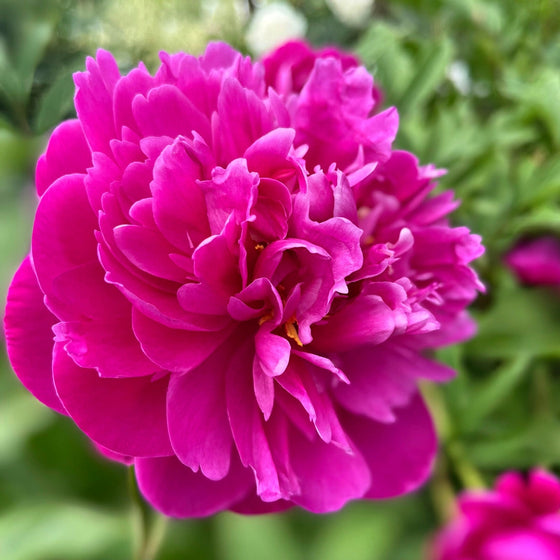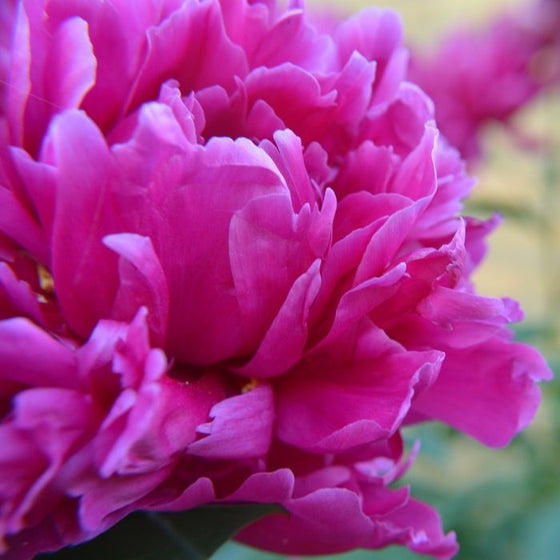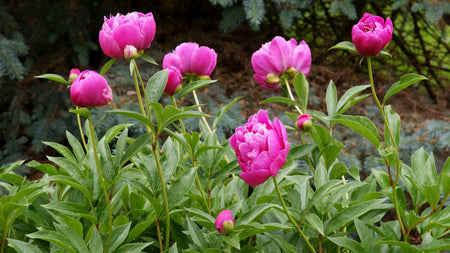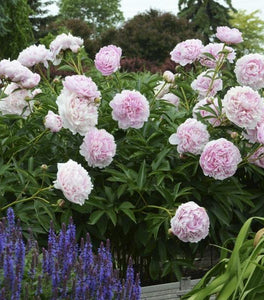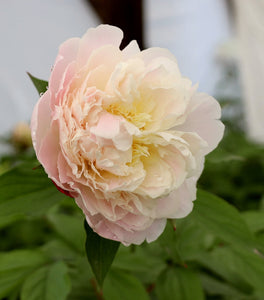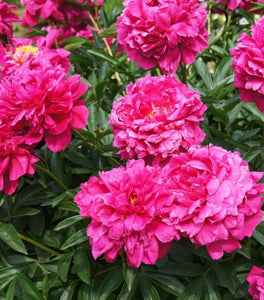
Images Depict Mature Plants
Karl Rosenfield Peonies
Karl Rosenfield Peony is a classic garden favorite celebrated for its bold, double blooms in rich, deep crimson-red hues. Each flower is packed with layers of ruffled petals, creating a lush, rose-like appearance that adds drama and elegance to the late spring garden. With its fragrant blossoms and vibrant color, this heirloom peony variety has remained a timeless staple in perennial borders and cutting gardens for over a century. The blooms stand out beautifully against the plant’s deep green, glossy foliage, which remains attractive even after the flowering season ends.
Growing to about 30–36 inches tall and wide, Karl Rosenfield Peony is perfect for foundation plantings, mixed borders, and formal garden designs. It performs best in full sun and well-drained, fertile soil, where it will return year after year with even more abundant blooms. Once established, peonies are long-lived perennials that require minimal maintenance, making them ideal for gardeners seeking reliable, show-stopping blooms with low effort. Their strong stems make them excellent for cut flower arrangements, bringing their dramatic color and sweet fragrance indoors.
Hardy in USDA Zones 3–8, Karl Rosenfield Peony is both deer and rabbit resistant, making it a great option for gardens in wildlife-prone areas. Its bold color pairs beautifully with softer hues like lavender, pale pink, or white, and it thrives when planted alongside other sun-loving perennials like iris, salvia, or catmint. With its rich history, vivid color, and garden versatility, Karl Rosenfield Peony is a must-have for anyone looking to add classic charm and standout blooms to their landscape.

| Hardiness Zone: | 3-8 |
|---|---|
| Mature Height: | 2 to 2.5 Feet |
| Mature Width: | 2 to 3 Feet |
| Sunlight: | Full sun |
| Water Requirements: | Water well until established |
| Flower Color: | Bright red double bloom |
| Details: | Bright red flowers, fragrant, good cut flower |
How to Care for Karl Rosenfield Peony
Be sure to read our planting instructions to ensure a healthy and happy Karl Rosenfield Peony plant for years to come!
How Do I Plant My Karl Rosenfield Peony Plants?
Planting your Karl Rosenfield Peony correctly is the key to enjoying years of lush blooms and vibrant garden color. Choose a location that receives full sun for at least six hours per day and features well-drained, fertile soil—peonies do not tolerate soggy conditions. Begin by digging a hole twice as wide and about 12 inches deep, loosening the soil at the bottom to promote healthy root growth. If you're planting a bare root peony, position the eyes (the pink or white growth buds) no more than 1 to 2 inches below the soil surface, as planting too deep can prevent blooming. Backfill with a mix of native soil and compost, water thoroughly, and apply a light mulch layer, keeping it a few inches away from the crown. Space your Karl Rosenfield Peony plants about 3 feet apart to allow for mature spread and proper air circulation, which helps prevent disease. These hardy perennials prefer to be left undisturbed once planted, so choose your site carefully and avoid transplanting unless absolutely necessary. The first year may produce limited flowers, but patience pays off—by the second or third year, your peonies will reward you with large, fragrant, double crimson-red blooms each spring. Ideal for sunny borders, foundation plantings, and cut flower gardens, Karl Rosenfield Peony will become a stunning focal point in your landscape for decades to come.
How do I water my Peony Karl Rosenfield Plants?
Watering your Karl Rosenfield Peony properly is essential for establishing healthy roots and producing abundant blooms. During the first growing season, keep the soil consistently moist but not soggy by watering deeply once or twice per week, depending on rainfall and soil drainage. Focus on watering at the base of the plant to avoid getting the foliage wet, which can reduce the risk of fungal disease. A 2–3 inch layer of mulch around the base will help retain moisture, suppress weeds, and regulate soil temperature—just be sure to keep mulch away from the crown to prevent rot. Once established, Karl Rosenfield Peonies are relatively drought tolerant, but they still benefit from deep, infrequent watering during hot, dry periods—typically about an inch of water per week. Overwatering or poorly drained soil can lead to root rot, so it’s important to let the soil dry slightly between waterings. Monitoring soil moisture regularly, especially during bud formation in spring and dry summer months, will help ensure your peonies thrive. With a consistent watering routine, these resilient perennials will reward you year after year with large, double crimson-red blooms that bring classic charm and bold color to the garden.
How do I fertilize My Karl Rosenfield Peonies?
Fertilizing your Karl Rosenfield Peony at the right time and with the proper nutrients can significantly enhance blooming and overall plant health. For best results, apply a balanced, slow-release fertilizer such as a 10-10-10 or 5-10-5 in early spring as new shoots begin to emerge. Spread the fertilizer around the base of the plant, staying several inches away from the crown, and water thoroughly to help the nutrients penetrate the soil. Avoid over-fertilizing, especially with high-nitrogen products, as this can lead to lush foliage at the expense of flower production. A second light application of fertilizer or compost can be made after the blooming period, helping to restore the plant’s energy reserves for the next growing season. Incorporating organic matter like compost or aged manure into the soil around your peony once a year can also improve soil structure and nutrient content. With proper fertilization and care, Karl Rosenfield Peonies will reward you with bold crimson-red, double blooms each spring, making them a standout addition to sunny borders, perennial beds, and cutting gardens. Consistent feeding supports strong root development, vibrant foliage, and long-term landscape performance.

How and When Do I Prune My Karl Rosenfield Peony Plants?
Pruning your Karl Rosenfield Peony is essential for maintaining plant health and promoting beautiful blooms year after year. The best time to prune is in the fall after the first frost, once the foliage has died back and turned brown. Use clean, sharp garden shears to cut all the stems down to about 1–2 inches above the ground, removing any dead or diseased foliage to prevent the spread of fungal issues over winter. Discard the clippings rather than composting them, as peony leaves can carry disease that may persist in compost piles. During the growing season, deadheading spent blooms encourages the plant to focus energy on root and stem development rather than seed production. Simply snip off faded flowers just above the nearest leaf set. However, avoid heavy pruning in spring, as Karl Rosenfield Peonies develop buds on established stems that form underground. Proper seasonal pruning, especially post-bloom and fall cleanup, ensures that your peonies stay vigorous, disease-free, and ready to produce their signature double crimson-red flowers each spring, enhancing the beauty of sunny borders, perennial gardens, and classic cottage landscapes.


